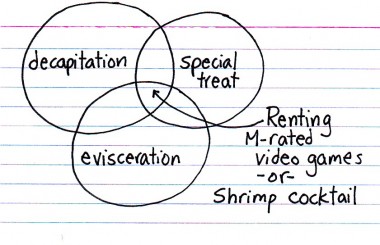Note: January 31- This wedge has been accreted at
Mountain Beltway. Lots and lots of geo-themed goodies to check out and drool over. Take a look!
The theme for this month's Accretionary Wedge (#30), hosted by Callan Bentley, is "
Bake Sale."
I hereby challenge my fellow geobloggers (and any newbies who want to participate) to explore the interconnections between geology and food. This can take any form you want, but I’m really hoping for some edible, geologically accurate models.
I'm actually fairly proficient in the kitchen, and I particularly love the alchemy that is baking: there is something magical (more about my use of that particular word later) about starting with an inedible white powder, and ending up with bread, pastries, cake or cookies. But lack of funds and difficulty getting to the grocery store makes it effectively impossible for me to actually create something of my own. (On the other hand, I have posted a number of these sorts of things other people have created in the past;
my favorite is here.)
So instead of another geocake- believe me, there are some really nice ones lined up- I've decided to focus more literally on "the interconnections between geology and food." When you're finished with this post, you will have not only (I hope) a better understanding of how baked goods are created, but a fun activity to do with students that helps drive home the deep connection between the non-living earth and its inhabitants. It probably won't be obvious where I'm going at first, but bear with me.

(
Elemental calcium from Wikipedia) Above is a test tube of calcium (Ca). For each of the elements I mention here, I will introduce it by name, follow it by its symbol, then stick mostly with the symbol or a compound name afterward. If the sample above was not enclosed in a test tube, it would react quickly with the atmosphere to form an earthy coating of oxides and nitrides. I don't know if calcium is available to the general public in the US, but it is readily available to classroom teachers and not too expensive.
SAFETY: CaO and the Ca[OH]2 solution are moderately caustic. Goggles should be worn, and for younger S's, you might want to consider latex/neoprene/plastic gloves. Students (S's) should be instructed to quickly wash off any skin contacts with either material, and to clean up any spills. These materials are pretty mild, as caustics go, but prolonged contact can cause chemical burns, and eye contact should be taken quite seriously- rinse for several minutes, and at a minimum, call for medical advice, though an ER visit would most likely not be necessary. H2 generated is flammable, and in large amounts, explosive, but in a decently ventilated space, and lacking ignition sources, this shouldn't be an issue.
So to start, place a small amount of Ca- a few grams- into a beaker or flask, then add water, let's say 50-75 ml. Calcium reacts quickly (though gently) with water to create hydrogen (H- in the real world, this exists as the diatomic molecule H2) and calcium hydroxide (also called "slaked lime," Ca[OH]2, where O is oxygen). The hydrogen can be harvested and used for other purposes, but that is beyond my scope here. The real goal here is to get that Ca[OH]2 solution, and a cheaper way, realistically, is simply to dissolve lime (CaO) in water. As it happens though, it's always been more convenient to use Ca, which has been available in every classroom I've worked, than lime, which is very inexpensive, but generally comes in unusable amounts (100 pound bags), and has never been laying around for me to use. A solution of calcium hydroxide is called, colloquially and archaically, "
lime water."
After a few minutes, the Ca will fully react and quit bubbling off H2, and what remains will be a cloudy suspension of Ca[OH]2 precipitate and solution. Place a filter paper in a funnel, and filter the mixture into an Erlenmeyer flask to remove the lime precipitate. The resulting supernatant should be more or less clear, but a small amount of cloudiness is unimportant. (Alternatively, simply letting the mixture settle for a while will allow you to pour or siphon off a clear portion of the solution, but this may not be practical in the time-limited classroom setting. Also, the teacher can simply prepare sufficient solution for classroom use ahead of time.)
If you followed the link to lime water above, you now know that this solution can be used as a test for carbon (C) dioxide, CO2. In fact, if you let it sit undisturbed and exposed to air, it will develop a thin crystalline crust as it reacts with CO2 in the atmosphere. But we're going to use a more concentrated source of that gas- ourselves.
Using a straw, exhale through the solution. Using Erlenmeyer flasks, with their constricted tops, helps to minimize splashing. Placing a piece of paper over the mouth of the flask can also help catch splashes, and as I mentioned earlier, S's should wear goggles. The solution will quickly turn cloudy, but continue blowing through it for several minutes. Keep in mind, the point is simply to expose the solution to CO2, not to make it as explosively splashy as possible (which some students will endeavor to do). The latter can also lead to hyperventilation and is a bad idea.

When exposed to CO2, clear limewater turns milky-
image from chem.wis.edu.
The precipitate that results from blowing through the lime water is CaCO3, or calcite. While technically not a mineral (see my discussion of
what does and doesn't constitute a mineral here) because we created it, and thus it's technically not "natural," for most purposes we can consider this to be the same as
micrite, or limy mud, which most often forms in calcium carbonate-saturated, warm, marine environments. Now, to me at least, there is something very amazing- I'm hesitant to use the word "magical," which connotes a very pleasurable state of mind to me, but holds a different meaning to most people, and one I don't intend- about this "artificial micrite." Those tiny mineral grains were, only a few moments earlier,
alive! And not just alive, but
me! What just came out of my lungs is instantly, "magically," a sediment on a tropical sea floor! I hope this excitement is not uniquely mine, because this intimate relationship between myself and natural earth processes is at the heart of my love of geology. It's certainly not the only thing there, but it is one of the central attachments.
Next step: either filter off the CaCO3, or allow it to settle (which may take 5-10 minutes, I don't remember exactly, but it's not too long) and pour off the supernatant. The goal here is to isolate and concentrate the precipitate, and how that's done is not important. Once you have the isolated precipitate, add a drop or few of acid: 0.1 M HCl, if you have it, but vinegar will work fine too. The acid test for calcite, if positive, will yield fizzing CO2, as the CaCO3 reacts to give a Ca salt, water, and CO2 gas. Again, the CO2 gas from acidifying your "micrite" is pretty special: a very short time ago it was tied up in cells all over your body. You are seeing a component of cellular waste that you rarely think about, and almost never directly perceive (unlike urine, for example).

Calcite reacts with acid to form CO2, from
About.com GeologySo, I hear you pleading, what in gawd's name does this have to do with baking? Well, it's that carbonate component, which within the limits imposed by typing, I'll designate --CO3: a carbonate ion with a minus 2 charge. There are unleavened breads- flour-based foods that have no component that causes them to rise- but these tend to be leathery or, if thick, downright brick-like. They are generally considered to be less desirable than leavened breads (though I have to admit, I'm a fan of crackers and
lebkuchen). Yeast breads get their rise from cellular wastes of the yeast cells- again, carbon dioxide gas. But the majority of flour-based food we think of as cake and pastry have as their leavening agent sodium (Na) bicarbonate, NaHCO3. Cookie recipes often call for baking soda- which is sodium bicarbonate. The heat causes basically the same decomposition as the acid does for our calcite, but more slowly and more gently, giving leavened cookies a little loft and making them softer.
More bready, cakey pastries often call for
baking powder, which are mixtures of sodium bicarbonate and temperature/moisture activated acids. From the wikilink:
Common low-temperature acid salts include cream of tartar and monocalcium phosphate (also called calcium acid phosphate). High-temperature acid salts include sodium aluminum sulfate, sodium aluminum phosphate, and sodium acid pyrophosphate
Why didn't I base this activity around sodium carbonate/bicarbonate rather than calcium carbonate? It would involve NaOH, which is seriously caustic, and something I prefer not to mess with if there are sensible alternatives. Further, as I tried to express above, there is something awesome and mesmerizing to me about seeing a mineral that was only moments ago part of my own metabolism. This is a critical understanding of the sciences generally, and geology specifically: life is
of the earth. We have no constituent components that were not originally unliving. The food we eat, the air we breathe, and the water we drink, we think of these as separate from ourselves, but fundamentally
ours. From the perspective of the planet, though (and granting that in any real sense, "the perspective of the planet" is a nonsensical phrase), those components are not separate, and they fundamentally belong to the earth more than they belong to us. We are granted the privilege of using them for a short time.
How many times, on average, has each carbon atom in the earth's near-surface cycled from the non-living lithosphere, atmosphere or hydrosphere into a living organism and back out to the non-living earth? I don't doubt that people far more competent than I have struggled to find meaningful and accurate estimates for this question. But I'm content to settle for the somewhat flippant answer "lotsa." And carbon is just one element- albeit the most important- among quite a number that are also biologically important. Every other element mentioned in this post, Ca, H, O, Na, and even Cl (chlorine) would be considered biologically important: life as we know it couldn't function without them. Along with carbon, each of those elements goes through its own cycles, its own set of reservoirs, of uses and transformations from non-living to living and back again.
And every time you take a bite of cake, and sigh blissfully, the cycle repeats once again.






















































